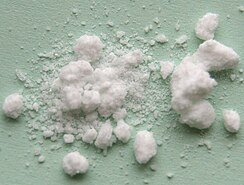| |||

| |||
| Names | |||
|---|---|---|---|
| IUPAC name
Hexacarbonylmolybdenum(0)
| |||
| Systematic IUPAC name
Hexacarbonylmolybdenum[1] | |||
| Identifiers | |||
3D model (JSmol)
|
|||
| ChEBI | |||
| ChemSpider | |||
| ECHA InfoCard | 100.034.271 | ||
| EC Number |
| ||
| 3798, 562210 | |||
| MeSH | Hexacarbonylmolybdenum | ||
PubChem CID
|
|||
| UN number | 3466 | ||
CompTox Dashboard (EPA)
|
|||
| |||
| |||
| Properties | |||
| C6MoO6 | |||
| Molar mass | 264.01 g·mol−1 | ||
| Appearance | Vivid, white, translucent crystals | ||
| Density | 1.96 g cm−3 | ||
| Melting point | 150 °C (302 °F; 423 K) | ||
| Boiling point | 156 °C (313 °F; 429 K) | ||
| insoluble | |||
| Solubility | slightly soluble in THF, diglyme, acetonitrile[2] | ||
| Structure | |||
| Orthogonal | |||
| Octahedral | |||
| 0 D | |||
| Thermochemistry | |||
Std enthalpy of
formation (ΔfH⦵298) |
−989.1 kJ mol−1 | ||
Std enthalpy of
combustion (ΔcH⦵298) |
−2123.4 kJ mol−1 | ||
| Hazards | |||
| GHS labelling: | |||

| |||
| Danger | |||
| H300, H310, H315, H319, H330, H413 | |||
| P261, P271, P280, P304+P340+P311, P405, P501 | |||
| NFPA 704 (fire diamond) | |||
| Safety data sheet (SDS) | External MSDS | ||
| Related compounds | |||
Related compounds
|
Chromium hexacarbonyl | ||
Except where otherwise noted, data are given for materials in their standard state (at 25 °C [77 °F], 100 kPa).
| |||
Molybdenum hexacarbonyl (also called molybdenum carbonyl) is the chemical compound with the formula Mo(CO)6. This colorless solid, like its chromium, tungsten, and seaborgium analogues, is noteworthy as a volatile, air-stable derivative of a metal in its zero oxidation state.
- ^ "Hexacarbonylmolybdenum (CHEBI:30508)". Chemical Entities of Biological Interest (ChEBI). UK: European Bioinformatics Institute.
- ^ Faller, John W.; Brummond, Kay M.; Mitasev, Branko (15 September 2006). "Hexacarbonylmolybdenum". Encyclopedia of Reagents for Organic Synthesis. Wiley. doi:10.1002/047084289X. hdl:10261/236866. ISBN 9780470842898.
- ^ Even, J.; Yakushev, A.; Dullmann, C. E.; Haba, H.; Asai, M.; Sato, T. K.; Brand, H.; Di Nitto, A.; Eichler, R.; Fan, F. L.; Hartmann, W.; Huang, M.; Jager, E.; Kaji, D.; Kanaya, J.; Kaneya, Y.; Khuyagbaatar, J.; Kindler, B.; Kratz, J. V.; Krier, J.; Kudou, Y.; Kurz, N.; Lommel, B.; Miyashita, S.; Morimoto, K.; Morita, K.; Murakami, M.; Nagame, Y.; Nitsche, H.; et al. (2014). "Synthesis and detection of a seaborgium carbonyl complex". Science. 345 (6203): 1491–3. Bibcode:2014Sci...345.1491E. doi:10.1126/science.1255720. PMID 25237098. S2CID 206558746. (subscription required)


